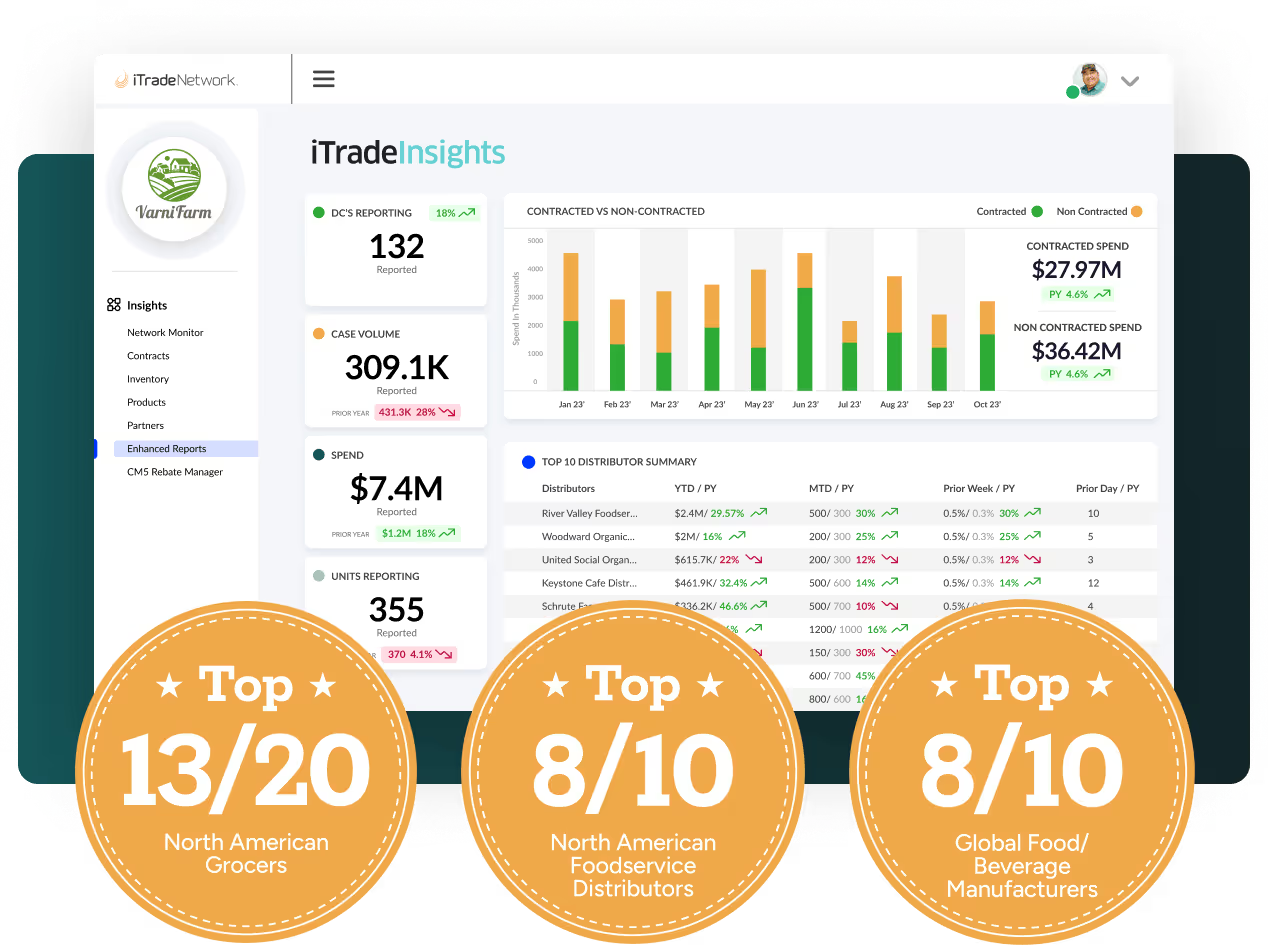What Success Looks Like: How Teams Transformed Trade Spend Reconciliation

5 Steps That Are Driving Real Impact
At iTradeNetwork, we partner with leading finance and accounting teams across the food and beverage supply chain. These teams have transformed trade spend reconciliation from a manual, error-prone process into an automated, streamlined workflow that delivers real-time visibility and measurable ROI.
Duplicate deductions, short-pays, and incorrect chargebacks lead to unclaimed revenue. For example, one global food manufacturer identified $12M in lost trade spend due to mismatched invoices and missing backup documentation. The use of predictive analytics can provide deeper insights into trade spend trends, allowing finance teams to anticipate potential reconciliation challenges before they arise.
The steps below reflect the approach our customers are using to reduce reconciliation time, recover margin, and gain full control of trade spend. Use this framework to evaluate your current process—and inspire your team’s next steps.
Step 1: Audit Your Current Workflow
Most finance teams know trade spend reconciliation is time-consuming—but few know exactly where the time and money are going. Manual processes, suspense accounts, and exception handling often go unchecked for too long. Conducting a simple audit reveals inefficiencies and uncovers opportunities to automate, prioritize, and recover lost margin.
- Where is revenue lost due to slow or missed validations?
- How long do deductions remain unresolved?
- What percentage of claims still require manual review?
☐ Review how much time is spent weekly on claim validation and dispute resolution
☐ Quantify unreconciled trade spend in suspense accounts
☐ Identify your top three bottlenecks slowing reconciliation
Step 2: Automate Claim Intake & Validation
Manual data entry is more than tedious—it introduces errors, slows cash flow, and creates reconciliation backlogs. Leading teams are leveraging automation to streamline claim intake, reduce mistakes, and move from reactive processing to proactive validation.
Rather than reviewing thousands of claims manually, they now:
- Extract data via OCR to eliminate manual entry
- Auto-flag exceptions (e.g., duplicate deductions, invalid rates, missing backup)
- Sync ERP and TPM systems for real-time status and accuracy
☐ Pilot OCR tools for high-volume invoice and deduction extraction
☐ Set up rule-based validation logic to reduce errors
☐ Integrate ERP and TPM systems to streamline updates and financial reporting
This shift alone can reduce reconciliation time by up to 75%—freeing Finance to focus on high-value analysis.
Step 3: Shift to Rolling Reconciliation
Relying on end-of-quarter cleanup creates risk, delays, and missed opportunities for recovery. Traditional reconciliation is too slow to keep up with the pace of business, especially when claim status updates are scattered across systems.
Modern finance teams gain agility by:
- Match claims to trade terms as they’re received
- Update financial records continuously
- Use real-time dashboards to track approvals, disputes, and risk areas
☐ Replace batch reconciliation with weekly or rolling updates
☐ Launch claim status dashboards for end-to-end visibility
☐ Set up alerts for exception-heavy claims or high-risk partners
Step 4: Standardize Financial Controls Without Slowing Down
Inconsistent validation rules and manual oversight expose companies to compliance risk, fraud, and margin erosion. But strong controls don’t have to add friction. With the right systems, you can enforce policy, catch anomalies early, and streamline audits.
Top-performing teams use automation and analytics to:
- Standardize validation criteria across all partners
- Detect fraud patterns and unusual claim activity
- Maintain audit-ready documentation for every deduction decision
☐ Establish shared validation rules across teams and trading partners
☐ Use predictive analytics to flag anomalies in real time
☐ Conduct rolling audits to reduce quarter-end pressure
Step 5: Enable Cross-Team Collaboration
Trade spend touches more than Finance. When Sales, Trade Marketing, and Procurement don’t have access to accurate claim data, disputes escalate, resolution slows, and accountability suffers.
Modern teams break silos by creating shared systems and workflows across departments.
☐ Provide shared access to live dashboards and claim history
☐ Automate alerts and workflows to reduce email back-and-forth
☐ Align teams on KPIs around claim accuracy, approvals, and cycle time
Want Help Bringing It to Life?
Trade spend reconciliation isn’t just a finance function—it’s a strategic opportunity to recover margin and accelerate decision-making. The longer teams wait to modernize, the more value slips through the cracks.
At iTradeNetwork, we help companies move from reactive cleanup to proactive optimization. The results speak for themselves:
- 75% faster claim resolution with automation that eliminates manual backlogs
- Significant margin recovery by catching invalid deductions and reducing errors
- Improved alignment across Finance, Sales, and Trade Marketing through shared visibility and smarter workflows
- Users report spending 8–10 hours per week reconciling invoices manually, which automation can virtually eliminate.
With iTradeNetwork, you don’t just fix the process—you turn trade spend into a lever for control, confidence, and competitive advantage.
Let’s connect and explore what’s possible for your team. Schedule a Demo today https://www.itradenetwork.com/schedule-a-demo
Speak to an Expert
Take a closer look at the platform built for buyers and their trading partners

What Success Looks Like: How Teams Transformed Trade Spend Reconciliation
5 Steps That Are Driving Real Impact
At iTradeNetwork, we partner with leading finance and accounting teams across the food and beverage supply chain. These teams have transformed trade spend reconciliation from a manual, error-prone process into an automated, streamlined workflow that delivers real-time visibility and measurable ROI.
Duplicate deductions, short-pays, and incorrect chargebacks lead to unclaimed revenue. For example, one global food manufacturer identified $12M in lost trade spend due to mismatched invoices and missing backup documentation. The use of predictive analytics can provide deeper insights into trade spend trends, allowing finance teams to anticipate potential reconciliation challenges before they arise.
The steps below reflect the approach our customers are using to reduce reconciliation time, recover margin, and gain full control of trade spend. Use this framework to evaluate your current process—and inspire your team’s next steps.
Step 1: Audit Your Current Workflow
Most finance teams know trade spend reconciliation is time-consuming—but few know exactly where the time and money are going. Manual processes, suspense accounts, and exception handling often go unchecked for too long. Conducting a simple audit reveals inefficiencies and uncovers opportunities to automate, prioritize, and recover lost margin.
- Where is revenue lost due to slow or missed validations?
- How long do deductions remain unresolved?
- What percentage of claims still require manual review?
☐ Review how much time is spent weekly on claim validation and dispute resolution
☐ Quantify unreconciled trade spend in suspense accounts
☐ Identify your top three bottlenecks slowing reconciliation
Step 2: Automate Claim Intake & Validation
Manual data entry is more than tedious—it introduces errors, slows cash flow, and creates reconciliation backlogs. Leading teams are leveraging automation to streamline claim intake, reduce mistakes, and move from reactive processing to proactive validation.
Rather than reviewing thousands of claims manually, they now:
- Extract data via OCR to eliminate manual entry
- Auto-flag exceptions (e.g., duplicate deductions, invalid rates, missing backup)
- Sync ERP and TPM systems for real-time status and accuracy
☐ Pilot OCR tools for high-volume invoice and deduction extraction
☐ Set up rule-based validation logic to reduce errors
☐ Integrate ERP and TPM systems to streamline updates and financial reporting
This shift alone can reduce reconciliation time by up to 75%—freeing Finance to focus on high-value analysis.
Step 3: Shift to Rolling Reconciliation
Relying on end-of-quarter cleanup creates risk, delays, and missed opportunities for recovery. Traditional reconciliation is too slow to keep up with the pace of business, especially when claim status updates are scattered across systems.
Modern finance teams gain agility by:
- Match claims to trade terms as they’re received
- Update financial records continuously
- Use real-time dashboards to track approvals, disputes, and risk areas
☐ Replace batch reconciliation with weekly or rolling updates
☐ Launch claim status dashboards for end-to-end visibility
☐ Set up alerts for exception-heavy claims or high-risk partners
Step 4: Standardize Financial Controls Without Slowing Down
Inconsistent validation rules and manual oversight expose companies to compliance risk, fraud, and margin erosion. But strong controls don’t have to add friction. With the right systems, you can enforce policy, catch anomalies early, and streamline audits.
Top-performing teams use automation and analytics to:
- Standardize validation criteria across all partners
- Detect fraud patterns and unusual claim activity
- Maintain audit-ready documentation for every deduction decision
☐ Establish shared validation rules across teams and trading partners
☐ Use predictive analytics to flag anomalies in real time
☐ Conduct rolling audits to reduce quarter-end pressure
Step 5: Enable Cross-Team Collaboration
Trade spend touches more than Finance. When Sales, Trade Marketing, and Procurement don’t have access to accurate claim data, disputes escalate, resolution slows, and accountability suffers.
Modern teams break silos by creating shared systems and workflows across departments.
☐ Provide shared access to live dashboards and claim history
☐ Automate alerts and workflows to reduce email back-and-forth
☐ Align teams on KPIs around claim accuracy, approvals, and cycle time
Want Help Bringing It to Life?
Trade spend reconciliation isn’t just a finance function—it’s a strategic opportunity to recover margin and accelerate decision-making. The longer teams wait to modernize, the more value slips through the cracks.
At iTradeNetwork, we help companies move from reactive cleanup to proactive optimization. The results speak for themselves:
- 75% faster claim resolution with automation that eliminates manual backlogs
- Significant margin recovery by catching invalid deductions and reducing errors
- Improved alignment across Finance, Sales, and Trade Marketing through shared visibility and smarter workflows
- Users report spending 8–10 hours per week reconciling invoices manually, which automation can virtually eliminate.
With iTradeNetwork, you don’t just fix the process—you turn trade spend into a lever for control, confidence, and competitive advantage.
Let’s connect and explore what’s possible for your team. Schedule a Demo today https://www.itradenetwork.com/schedule-a-demo
Unlock It Now!




